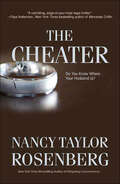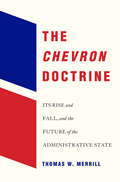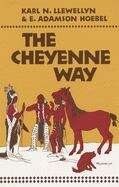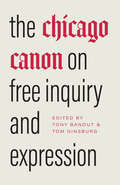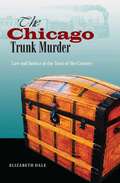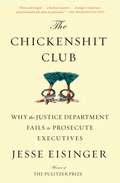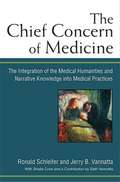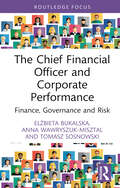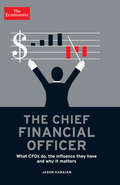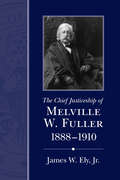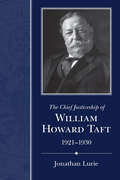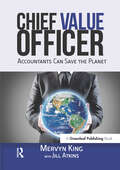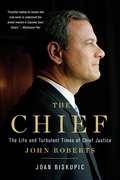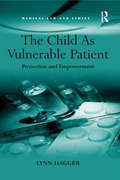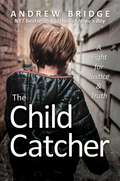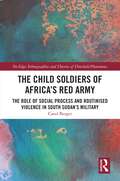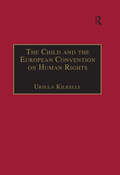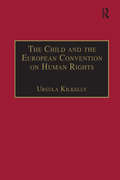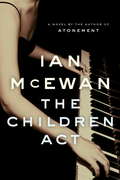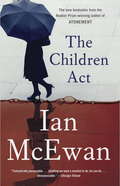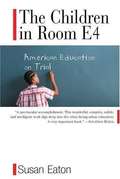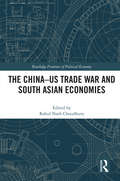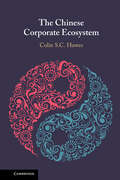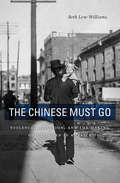- Table View
- List View
The Cheater
by Nancy Taylor RosenbergLily Forrester, a Ventura County judge, finds herself in a mix of bizarre circumstances that lead her onto the trail of a vicious criminal mind. Her husband calls her from a Las Vegas jail where he has been arrested for attempted rape—but Las Vegas wasn't on his itinerary. His accuser, Anne Bradley, is an enigmatic woman with an eerie past, a woman to whom Lily is strangely drawn. FBI Agent Mary Stevens is tracking a killer whose victims are husbands who cheat on their wives. Their mutilated bodies are disposed of in ghastly ways and strange locations. The murderer's trail leads to a web service that provides alibis for cheating spouses and into a thick web of deception that puts both Lily's and Mary's lives in jeopardy. At the Publisher's request, this title is being sold without Digital Rights Management Software (DRM) applied.
The Chevron Doctrine: Its Rise and Fall, and the Future of the Administrative State
by Thomas W. MerrillA leading expert on the administrative state describes the past, present, and future of the immensely consequential—and equally controversial—legal doctrine that has come to define how Congress’s laws are applied by the executive branch. The Constitution makes Congress the principal federal lawmaker. But for a variety of reasons, including partisan gridlock, Congress increasingly fails to keep up with the challenges facing our society. Power has inevitably shifted to the executive branch agencies that interpret laws already on the books and to the courts that review the agencies’ interpretations. Since the Supreme Court’s 1984 decision in Chevron v. Natural Resources Defense Council, this judicial review has been highly deferential: courts must uphold agency interpretations of unclear laws as long as these interpretations are “reasonable.” But the Chevron doctrine faces backlash from constitutional scholars and, now, from Supreme Court justices who insist that courts, not administrative agencies, have the authority to say what the law is. Critics of the administrative state also charge that Chevron deference enables unaccountable bureaucratic power. Thomas Merrill reviews the history and immense consequences of the Chevron doctrine and suggests a way forward. Recognizing that Congress cannot help relying on agencies to carry out laws, Merrill rejects the notion of discarding the administrative state. Instead, he focuses on what should be the proper relationship between agencies and courts in interpreting laws, given the strengths and weaknesses of these institutions. Courts are better at enforcing the rule of law and constitutional values; agencies have more policy expertise and receive more public input. And, unlike courts, agencies are subject to at least some political discipline. The best solution, Merrill suggests, is not of the either-or variety. Neither executive agencies nor courts alone should pick up the slack of our increasingly ineffectual legislature.
The Cheyenne Way (The Civilization Of The American Indian Series #Book Twenty-One)
by Karl N. Llewellyn E. Adamson HoebelTHE Cheyenne Indians are one of the famous tribes of the Great American Plains. Divided as they were after 1833, into a northern division which centered its life in the high plains of southeastern Montana and eastern Wyoming, and a southern division which centered in western Oklahoma and eastern Colorado, they wove a web of their activities across the entire breadth of the Great Plains. They were known to the travelers of both the Oregon and Santa Fe trails. Originally inhabitants of the woodland lake country of the upper Mississippi valley, they had come at the beginning of the century past to an effective adoption of the new horse culture and buffalo-hunting economy of the Plains tribes.
The Chicago Canon on Free Inquiry and Expression
by Tom Ginsburg Tony BanoutA collection of texts that provide the foundation for the University of Chicago’s longstanding tradition of free expression, principles that are at the center of current debates within higher education and society more broadly. Free inquiry and expression are hotly contested, both on campus and in social and political life. Since its founding in the late nineteenth century, the University of Chicago has been at the forefront of conversations around free speech and academic freedom in higher education. The University’s approach to free expression grew from a sterling reputation as a research university as well as a commitment to American pragmatism and democratic progress, all of which depended on what its first president referred to as the “complete freedom of speech on all subjects.” In 2015, more than 100 years later, then University provost and president J. D. Isaacs and Robert Zimmer echoed this commitment, releasing a statement by a faculty committee led by law professor Geoffrey R. Stone that has come to be known as the Chicago Principles, now adopted or endorsed by one hundred US colleges and universities. These principles are just a part of the long-standing dialogue at the University of Chicago around freedom of expression—its meaning and limits. The Chicago Canon on Free Inquiry and Expression brings together exemplary documents – some published for the first time here – that explain and situate this ongoing conversation with an introductory essay that brings the tradition to light. Throughout waves of historical and societal challenges, this first principle of free expression has required rearticulation and new interpretations. The documents gathered here include, among others, William Rainey Harper’s “Freedom of Speech” (1900), the Kalven Committee’s report on the University’s role in political and social action (1967), and Geoffrey R. Stone’s “Free Speech on Campus: A Challenge of Our Times” (2016). Together, the writings of the canon reveal how the Chicago tradition is neither static nor stagnant, but a vibrant experiment; a lively struggle to understand, practice, and advance free inquiry and expression. At a time of nationwide campus speech debates, engaging with these texts and the questions they raise is essential to sustaining an environment of broad intellectual and ideological diversity. This book offers a blueprint for the future of higher education’s vital work and points to the civic value of free expression.
The Chicago Trunk Murder: Law and Justice at the Turn of the Century
by Elizabeth DaleOn November 14, 1885, a cold autumn day in the City of Broad Shoulders, an enthusiastic crowd of several hundred watched as three Sicilians Giovanni Azari, Agostino Gelardi, and Ignazio Silvestri were hanged in the courtyard of the Cook County Jail. The three had only recently come to the city, but not long after they were arrested, tried, and convicted for murdering Filippo Caruso, stuffing his body into a trunk, and shipping it to Pittsburgh. Historian and legal expert Elizabeth Dale brings the Trunk Murder case vividly back to life, painting an indelible portrait of nineteenth-century Chicago, ethnic life there, and a murder trial gone seriously awry. Along the way she reveals a Windy City teeming with street peddlers, crooked cops, earnest reformers, and legal activists—all of whom play a part in this gripping tale. Chicago's Trunk Murder shows how the defendants in the case were arrested on dubious evidence and held, some for weeks, without access to lawyers or friends. The accused finally confessed after being interrogated repeatedly by men who did not speak their language. They were then tried before a judge who had his own view and ruled accordingly. Chicago's Trunk Murder revisits these abject breaches of justice and uses them to consider much larger problems in late nineteenth century criminal law. Written with a storyteller's flair for narrative and brimming with historical detail, this book will be must reading for true crime buffs and aficionados of Chicago lore alike.
The Chickenshit Club: Why the Justice Department Fails to Prosecute Executives
by Jesse EisingerFrom Pulitzer Prize–winning journalist Jesse Eisinger, a blistering account of corporate greed and impunity, and the reckless, often anemic response from the Department of Justice.Why were no bankers put in prison after the financial crisis of 2008? Why do CEOs seem to commit wrongdoing with impunity? The problem goes beyond banks deemed “Too Big to Fail” to almost every large corporation in America—to pharmaceutical companies and auto manufacturers and beyond. The Chickenshit Club—an inside reference to prosecutors too scared of failure and too daunted by legal impediments to do their jobs—explains why. A character-driven narrative, the book tells the story from inside the Department of Justice. The complex and richly reported story spans the last decade and a half of prosecutorial fiascos, corporate lobbying, trial losses, and culture shifts that have stripped the government of the will and ability to prosecute top corporate executives. The book begins in the 1970s, when the government pioneered the notion that top corporate executives, not just seedy crooks, could commit heinous crimes and go to prison. The book travels to trading desks on Wall Street, to corporate boardrooms and the offices of prosecutors and F.B.I agents. These revealing looks provide context for the evolution of the Justice Department’s approach to pursuing corporate criminals through the early aughts and into the Justice Department of today. Exposing one of the most important scandals of our time, The Chickenshit Club provides a clear, detailed explanation as to how our Justice Department has come to avoid, bungle, and mismanage the fight to bring these alleged criminals to justice.
The Chief Concern of Medicine: The Integration of the Medical Humanities and Narrative Knowledge into Medical Practices
by Ronald Schleifer Vannatta Jerry B.Unlike any existing studies of the medical humanities, The Chief Concern of Medicine brings to the examination of medical practices a thorough---and clearly articulated---exposition of the nature of narrative. The book builds on the work of linguistics, semiotics, narratology, and discourse theory and examines numerous literary works and narrative "vignettes" of medical problems, situations, and encounters. Throughout, the book presents usable expositions of the ways storytelling organizes itself to allow physicians and other healthcare workers (and even patients themselves) to be more attentive to and self-conscious about the information---the "narrative knowledge"---of the patient's story.
The Chief Financial Officer and Corporate Performance: Finance, Governance and Risk (Routledge Focus on Economics and Finance)
by Elżbieta Bukalska Anna Wawryszuk-Misztal Tomasz SosnowskiFinancial management encompasses a set of complex activities that should be performed by a professional financial manager. Some financial decisions are riskier than others, and as such can result in higher or lower profitability. This risk-return trade-off is the key aspect of financial management. Furthermore, a financial director’s propensity to take risks can lead to less or more conservative financial decisions.This study firstly provides theoretical issues on financial management and the results of previous research, while the second part is empirical, showing the methodology and results of the authors’ research. Apart from CFO risk attitude, the book also examines CFO power. The book highlights the importance of the position of financial managers in companies and demonstrates that financial decisions are the reflection of decision-makers’ characteristics. Additionally, the book provides evidence of whether the COVID-19 crisis has increased or decreased the impact of CFO characteristics on financial decision-making and firm performance.The book will attract the attention of researchers and students of corporate finance and accounting and also contains many valuable tips and insights for practitioners.
The Chief Financial Officer: What CFOs Do, the Influence they Have, and Why it Matters (Economist Books)
by The Economist Jason KaraianThe rapid rise in importance of the role of the chief financial officer--from back-office accountant to front-line executive--is unrivaled by that of any other corporate position. With access to every facet of the business, CFOs now wield a level of influence matched only by chief executives.This book explains how CFOs earned their privileged status, and what the future may hold for them. It describes their ever-expanding role, and how they are reshaping their departments to help them deal with that transformation. Insights from current and former CFOs provide a first-hand perspective on finance leaders' aspirations and doubts. It is a useful reference for finance chiefs seeking to learn from peers and benchmark their own performance; for those looking to build a career in the C-Suite; for managers seeking to improve their relationship with the finance department; for service providers-banks, accountancies and consulting firms--and anyone else who wants to get on the good side of the keeper of the corporate checkbook.
The Chief Justiceship of Melville W. Fuller, 1888–1910 (Chief Justiceships of the United States Supreme Court)
by James W. Ely Jr.A study of the man who led the Supreme Court as the nineteenth century ended and the twentieth began, exploring issues of property, government authority, and more. In this comprehensive interpretation of the Supreme Court during the pivotal tenure of Melville W. Fuller, James W. Ely Jr., provides a judicial biography of the man who led the Court from 1888 until 1910 as well as a comprehensive and thoughtful analysis of the jurisprudence dispensed under his leadership. Highlighting Fuller&’s skills as a judicial administrator, Ely argues that a commitment to economic liberty, the security of private property, limited government, and states&’ rights guided Fuller and his colleagues in their treatment of constitutional issues. Ely directly challenges the conventional idea that the Fuller Court adopted laissez-faire principles in order to serve the needs of business. Rather, Ely presents the Supreme Court&’s efforts to safeguard economic rights not as a single-minded devotion to corporate interests but as a fulfillment of the property-conscious values that shaped the constitution-making process in 1787. The resulting study illuminates a range of related legal issues, including the Supreme Court&’s handling of race relations, criminal justice, governmental authority, and private law disputes.
The Chief Justiceship of William Howard Taft, 1921–1930 (Chief Justiceships of the United States Supreme Court)
by Jonathan LurieA study of the Supreme Court tenure of the only US president to serve as chief justice provides a unique perspective on 1920s America. In this book, Jonathan Lurie offers a comprehensive examination of the Supreme Court tenure of the only person to have held the offices of president of the United States and chief justice of the United States Supreme Court. William Howard Taft joined the Court during the Jazz Age and the era of prohibition, a period of disillusion and retreat from the idealism reflected during Woodrow Wilson&’s presidency. Lurie considers how conservative trends at this time were reflected in key decisions of Taft&’s court. Although Taft was considered an undistinguished chief executive, such a characterization cannot be applied to his tenure as chief justice. Lurie demonstrates that Taft&’s leadership on this tribunal, matched by his productive relations with Congress, in effect created the modern Supreme Court. Furthermore he draws on the unpublished letters Taft wrote to his three children, Robert, Helen, and Charles, generally once a week. His missives contain an intriguing mixture of family news, insights concerning contemporaneous political issues, and occasional commentary on his fellow justices and cases under consideration. Lurie structures his study in parallel with the eight full terms in which Taft occupied the center seat, examining key decisions while avoiding legal jargon wherever possible. The high point of Taft&’s chief justiceship was the period from 1921 to 1925. The second part of his tenure was marked by slow decline as his health worsened with each passing year. By 1930 he was forced to resign, and his death soon followed. In an epilogue Lurie explains why Taft is still regarded as an outstanding chief justice—if not a great jurist—and why this distinction is important. &“Conflicts from the early twentieth century endure, and Lurie gives us old and new perspectives from which to understand a living Constitution.&” —Journal of American History
The Chief Value Officer: Accountants Can Save the Planet
by Jill Atkins Mervyn KingIntegrated Reporting is having a profound impact on corporate thinking and reporting. Value is being assessed on the basis of the sources of value creation used by an organisation and not through a financial lens alone. In Chief Value Officer: Accountants Can Save the Planet, Mervyn King, a global corporate governance and reporting leader, challenges some of the systemic issues preventing organisations from managing in an integrated value-creation way.The shareholder-centric governance model, currently favoured by most companies, will not result in changes to corporate behaviour that can create value in a sustainable manner. The book, therefore, firmly places the accountant in the position of changemaker – the finance professional today should be more of a value officer than a financial officer. Consequently, the Chief Finance Officer should be known as the Chief Value Officer.This book explains this new approach. It encapsulates the essential reasons for adopting integrated reporting, explains its application to date and proposes the next steps needed to achieve change that will improve business, social and environmental sustainability.
The Chief: The Life and Turbulent Times of Chief Justice John Roberts
by Joan BiskupicAn incisive biography of the Supreme Court's enigmatic Chief Justice, taking us inside the momentous legal decisions of his tenure so far John Roberts was named to the Supreme Court in 2005 claiming he would act as a neutral umpire in deciding cases. His critics argue he has been anything but, pointing to his conservative victories on voting rights and campaign finance. Yet he broke from orthodoxy in his decision to preserve Obamacare. How are we to understand the motives of the most powerful judge in the land? In The Chief, award-winning journalist Joan Biskupic contends that Roberts is torn between two, often divergent, priorities: to carry out a conservative agenda, and to protect the Court's image and his place in history. Biskupic shows how Roberts's dual commitments have fostered distrust among his colleagues, with major consequences for the law. Trenchant and authoritative, The Chief reveals the making of a justice and the drama on this nation's highest court.
The Child As Vulnerable Patient: Protection and Empowerment (Medical Law and Ethics)
by Lynn HaggerHow can medical law and ethics take forward the issue of children's empowerment and protection? What are the key factors in considering the balance between protecting the welfare of the young and allowing them rights to autonomy? The Child as Vulnerable Patient investigates the role that a human rights approach can play in establishing the parameters of autonomy and discusses the opportunities presented in the Human Rights Act, the European Convention on the Rights of the Child and new policy initiatives in the NHS. A valuable addition to existing literature in this area, this volume will be of interest to lawyers, health professionals and students of medical law.
The Child Buyer: A Novel
by John HerseyAn imaginary, utterly absorbing record of the investigations of the Committee on Education, Welfare, and Public Morality of an unnamed state senate into the activities of Mr. Wissey Jones, who has come to the town of Pequot on what he says is urgent defense business. The hearings develop the suspense of a bizarre trial. It soon becomes clear that Mr. Jones buys for his corporation children of a certain sort, and that he is eager to acquire a ten-year-old named Barry Rudd, who manifests the breathtaking, prickly, sometimes obnoxious, but also deeply moving precocity of a potential genius. The dramatic conflicts exposed during the hearing revolve around the questions of exactly why Mr. Jones’s company buys children, and whether he will succeed in buying Barry. The Child Buyeris a biting commentary on some aspects of American education, on the uses of high intelligence, and on the means of defending democracy. Mr. Hersey makes fine use of the classical weapons of satire—humor and high spirits, sweet dream and nightmare, grotesqueness in the heart of normalcy—to attack not any single theory of education, but the notions that education can be an exact science; that superior minds can be set free by a national crash program; that children can be regarded as weapons; and that talent can be processed and stored for profit and defense. Although these extraordinary hearings end in a kind of horror, involving the slide into corruption or rascality or apathy of almost everyone connected with them, nevertheless the book leaves in the reader’s mind a powerful affirmation—a case for individuality, freedom of thought, integrity, faith in the young, and, above all, a better understanding of human needs in a darkling world.
The Child Catcher: A Fight for Justice and Truth
by Andrew BridgeThe Child Catcher is the true story of the fight to rescue the children confined to a violent and secretive institution in the rural South.Andrew Bridge&’s bestselling memoir, Hope&’s Boy, told the story of his survival after he was taken from his mother, who struggled with schizophrenia, and was left to foster care. Bridge was first confined at one of our country&’s most notorious children&’s institutions, MacLaren Hall. Now, in The Child Catcher, he chronicles his role in the longest-running, most bitterly fought mental health lawsuit in American history. After graduating from Harvard Law School, Bridge joined the small team of civil rights lawyers representing the children of the Eufaula Adolescent Center, a violent and secretive institution in the rural South, against the State of Alabama. Eufaula was a place Alabama had refused to surrender. Parents were lured into sending their children there, unable to get them back. Thousands of children went through Eufaula, just as thousands went through the institution that Bridge survived as a boy. The fight for justice led him through squatters&’ camps in backwoods and into the lives of families caught in a permanent underclass. He sat with children as they struggled to explain what had gone wrong in their lives. In this David and Goliath battle, The Child Catcher is the story of Bridge&’s personal redemption and the hope that justice for children is possible.
The Child Soldiers of Africa's Red Army: The Role of Social Process and Routinised Violence in South Sudan's Military (On Edge: Ethnographies and Theories of Threshold Phenomena)
by Carol BergerThis book examines the role of social process and routinised violence in the use of underaged soldiers in the country now known as South Sudan during the twenty-two-year civil war between Sudan’s northern and southern regions. Drawing on accounts of South Sudanese who as children and teenagers were part of the Red Army—the youth wing of the Sudan People’s Liberation Army (SPLA)— the book sheds light on the organised nature of the exploitation of children and youth by senior adult figures within the movement. The book also includes interviews with several of the original Red Army commanders, all of whom went on to hold senior positions within the military and government of South Sudan. The author chronicles the cultural transformation experienced by members of the Red Army and considers whether an analysis of the processes involved in what was then Africa’s longest civil war can aid our understanding of South Sudan’s more recent descent into ethnicised conflict. As such, it will appeal to scholars of sociology, anthropology and political science with interests in ethnography, conflict and the military exploitation of children.
The Child and the European Convention on Human Rights
by Ursula KilkellyThe European Convention on Human Rights is the most successful system for the enforcement of human rights in the world. However, to date its full potential for protecting children’s rights has not been explored as attention has focused on the UN Convention on the Rights of the Child. This unique book provides the first analysis of the extensive case law of the Commission and the Court of Human Rights on all issues concerning children and their rights. This study is important as a study of the regional protection of children’s rights and, moreover, the case law itself can be directly applied in the legal system of nearly every European country, including the UK. The book includes chapters on the rights of the child under the European Convention on Human Rights in relation to education, protection from abuse, the right to identity, child care, juvenile justice, health care and immigration and the family. It also explores the potential of the Strasbourg mechanism for the protection of children’s rights and thus provides a practical and vital guide to the study and use of the European Convention in the broad area of children’s rights.
The Child and the European Convention on Human Rights: Second Edition
by Ursula KilkellyThe European Convention on Human Rights is the most successful system for the enforcement of human rights in the world. However, to date its full potential for protecting children’s rights has not been explored as attention has focused on the UN Convention on the Rights of the Child. This unique book provides the first analysis of the extensive case law of the Commission and the Court of Human Rights on all issues concerning children and their rights. This study is important as a study of the regional protection of children’s rights and, moreover, the case law itself can be directly applied in the legal system of nearly every European country, including the UK. The book includes chapters on the rights of the child under the European Convention on Human Rights in relation to education, protection from abuse, the right to identity, child care, juvenile justice, health care and immigration and the family. It also explores the potential of the Strasbourg mechanism for the protection of children’s rights and thus provides a practical and vital guide to the study and use of the European Convention in the broad area of children’s rights.
The Children Act
by Ian McewanA brilliant, emotionally wrenching new novel from the author of Atonement and Amsterdam. Fiona Maye is a High Court judge in London presiding over cases in family court. She is fiercely intelligent, well respected, and deeply immersed in the nuances of her particular field of law. Often the outcome of a case seems simple from the outside, the course of action to ensure a child's welfare obvious. But the law requires more rigor than mere pragmatism, and Fiona is expert in considering the sensitivities of culture and religion when handing down her verdicts. But Fiona's professional success belies domestic strife. Her husband, Jack, asks her to consider an open marriage and, after an argument, moves out of their house. His departure leaves her adrift, wondering whether it was not love she had lost so much as a modern form of respectability; whether it was not contempt and ostracism she really fears. She decides to throw herself into her work, especially a complex case involving a seventeen-year-old boy whose parents will not permit a lifesaving blood transfusion because it conflicts with their beliefs as Jehovah's Witnesses. But Jack doesn't leave her thoughts, and the pressure to resolve the case--as well as her crumbling marriage--tests Fiona in ways that will keep readers thoroughly enthralled until the last stunning page.
The Children Act
by Ian McewanFiona Maye is a leading High Court judge who presides over cases in the family court. She is renowned for her fierce intelligence, exactitude, and sensitivity. But her professional success belies private sorrow and domestic strife. There is the lingering regret of her childlessness, and now her marriage of thirty years is in crisis.At the same time, she is called on to try an urgent case: Adam, a beautiful seventeen-year-old boy, is refusing for religious reasons the medical treatment that could save his life, and his devout parents echo his wishes. Time is running out. Should the secular court overrule sincerely expressed faith? In the course of reaching a decision, Fiona visits Adam in the hospital--an encounter that stirs long-buried feelings in her and powerful new emotions in the boy. Her judgment has momentous consequences for them both.parents will not permit a lifesaving blood transfusion because it conflicts with their beliefs as Jehovah's Witnesses. But Jack doesn't leave her thoughts, and the pressure to resolve the case--as well as her crumbling marriage--tests Fiona in ways that will keep readers thoroughly enthralled until the last stunning page.
The Children in Room E4: American Education on Trial
by Susan EatonThe story of a star student Jeremy, his friends and their teacher Luddy, who face great challenges in their school cut off from mainstream America also portrays the glaring truth of racial and economic divide found across the urban centres of America.
The China-US Trade War and South Asian Economies (Routledge Frontiers of Political Economy)
by Rahul Nath ChoudhuryThe USA and China, the world’s largest economic powers, have been engaging in trade war since January 2018. The impact of this trade war is felt not only by US and China but also by other economies who have economic ties with them. This book provides insights into damages caused by this trade war. The first section of the book looks at the impact of the trade war on the global economy. It goes deeper to examine the trade war impact on the South Asian region. It is well-known that any imposition of new tariffs or an increase in existing tariffs would make imports more costly and render the exported goods less competitive. Yet, the book posits that the trade war has provided a window of opportunity to other countries not caught in it. The South Asian region, with countries like Bangladesh, India and Sri Lanka, has actually reaped benefits from the widening trade dispute between the world’s two biggest economies. This book will be a useful reference to help policymakers to undertake informed decisions and initiate programs to minimise the trade war impact.
The Chinese Corporate Ecosystem
by Colin S. HawesChallenging simplistic claims that Chinese corporations merely serve Communist Party goals, this book argues we cannot understand these corporations without tracing their dynamic evolution within a unique socio-political ecosystem. Vivid case studies illuminate the strange hybrid structures and networks that are essential for corporate success in the Chinese habitat. Tracing the reciprocal impacts between Chinese corporations and their environment, Colin S. C. Hawes reveals how corporations' political adaptations have raised serious obstacles for their international expansion and worsened China's environmental crisis. Adopting an interdisciplinary approach that synthesizes insights from behavioural economics, science and Chinese philosophy, this book proposes innovative solutions to the damaging impacts of Chinese corporations. It makes a compelling case for redirecting the vital energy of corporations and government officials in more productive and sustainable directions.
The Chinese Must Go: Violence, Exclusion, And The Making Of The Alien In America
by Beth Lew-WilliamsBeth Lew-Williams shows how American immigration policies incited violence against Chinese workers, and how that violence provoked new exclusionary policies. Locating the origins of the modern American “alien” in this violent era, she makes clear that the present resurgence of xenophobia builds mightily upon past fears of the “heathen Chinaman.”
